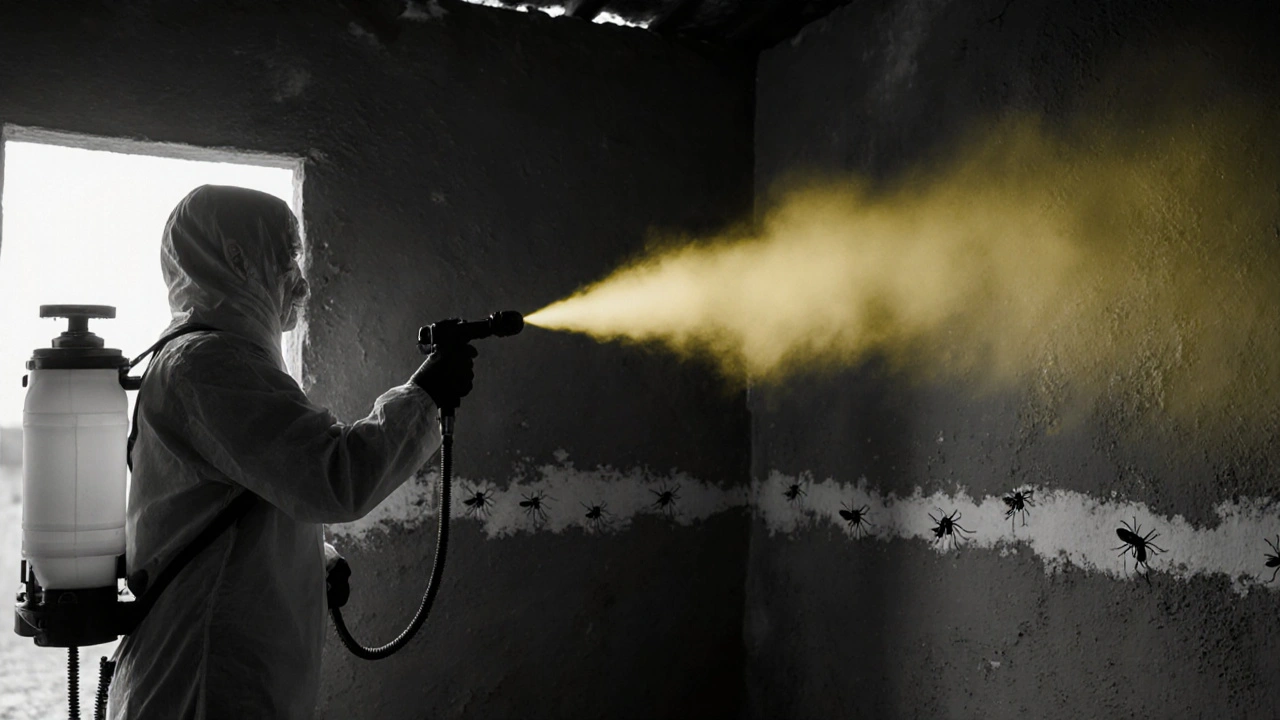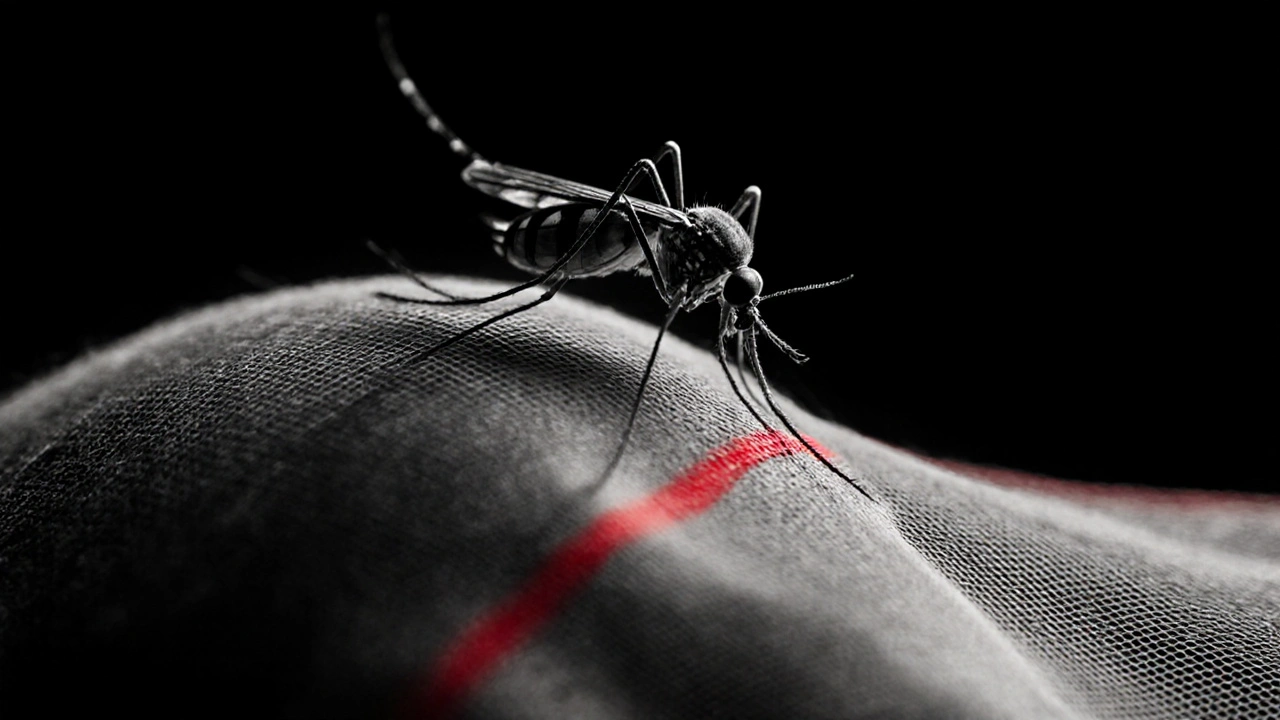Malaria Vector Control Cost & Effectiveness Calculator
Input Your Community Details
Results
When we talk about Insecticides are chemicals designed to kill or repel insects, and in the fight against malaria they serve as the backbone of vector‑control strategies. Their primary job is to reduce the population of Anopheles mosquitoes, the carriers of the Malaria parasite, thereby cutting transmission to humans. Over the past two decades, insecticides have helped lower global malaria deaths by more than 60%, but their role is evolving as resistance spreads and new tools emerge.
Why Insecticides Matter in Malaria Control
The World Health Organization (WHO) sets the benchmark for malaria control programs worldwide. Their guidelines stress that killing adult mosquitoes, either indoors or on sleeping surfaces, is the most cost‑effective way to protect vulnerable populations. Insecticides achieve this in two ways: (1) Indoor Residual Spraying (IRS), which coats walls and ceilings with a long‑lasting chemical, and (2) Insecticide‑Treated Nets (ITNs), which combine a physical barrier with a dose of insecticide that kills or repels mosquitoes on contact.
Key Insecticide Classes Used Today
Four chemical families dominate the malaria‑control toolbox:
- Pyrethroids: fast‑acting, low toxicity to humans, and the only class approved for ITNs. They account for about 80% of all insecticide use in malaria programs.
- Organophosphates: work by inhibiting nerve enzymes in mosquitoes; often used for IRS where pyrethroid resistance is high.
- Carbamates: similar mode of action to organophosphates, offering an alternative when resistance to both classes emerges.
- Neonicotinoids: newer on the scene, provide a different target site and are being trialed for IRS in a few African nations.
Each class carries specific advantages and drawbacks in terms of cost, residual life on surfaces, and safety profile, which program managers weigh when designing a control strategy.
Indoor Residual Spraying (IRS): How It Works and What to Expect
IRS involves applying a measured amount of insecticide to interior walls, usually twice a year. The sprayed surface remains lethal to mosquitoes for 3-6 months, depending on the chemical and wall material. A typical IRS campaign covers 70-80% of households in a target district, aiming to create a “mortality wall” that kills mosquitoes before they can bite.
Effectiveness data from the President’s Malaria Initiative (PMI) show that in areas with high IRS coverage, malaria incidence dropped by an average of 45% within a year. However, the success of IRS hinges on several operational factors:
- Accurate mapping of dwellings to ensure >80% coverage.
- Selection of an insecticide class to which the local mosquito population is still susceptible.
- Community acceptance; residents must keep walls clean and avoid repainting for the spray’s duration.
When any of these elements falters, the impact dwindles quickly.

Insecticide‑Treated Nets (ITNs): The Everyday Shield
ITNs are simple, low‑tech, and highly effective. A standard long‑lasting ITN (LLIN) is treated with 0.2% pyrethroid and retains its insecticidal activity for up to three years, even after dozens of washes. The net creates a barrier that prevents mosquito bites while the insecticide kills any mosquito that lands on it.
Randomized controlled trials in Tanzania and Kenya demonstrated a 50% reduction in child mortality when households adopted ITNs. Moreover, scaling up ITN distribution to achieve universal coverage (one net per two people) is a cornerstone of the WHO’s Global Technical Strategy for Malaria 2020‑2030.
Key challenges include:
- Physical wear‑and‑tear that creates holes, reducing protection.
- Pyrethroid resistance, which can cut net efficacy by up to 30% in some hotspots.
- Behavioural shifts in mosquitoes, such as biting earlier in the evening outdoors, which bypass the net’s protection window.
Resistance Management: The Growing Threat
Insecticide resistance occurs when mosquito populations develop genetic mutations that reduce the toxic effect of a chemical. The WHO’s 2022 resistance map shows that over 70% of surveyed African malaria vectors are resistant to pyrethroids, the workhorse of ITNs.
Resistance management strategies have three pillars:
- Rotating insecticide classes for IRS to avoid continuous selection pressure.
- Mixing or pyramiding chemicals on nets - for example, combining pyrethroids with a synergist like piperonyl butoxide (PBO) that blocks resistance enzymes.
- Integrating Vector Control tools beyond chemicals, such as larval source management and housing improvements.
Monitoring resistance through WHO’s standard susceptibility tests is essential. Programs that ignore rising resistance often see a rebound in malaria cases within two years.
Comparing IRS and ITNs: Which Fits Your Setting?
| Attribute | Indoor Residual Spraying (IRS) | Insecticide‑Treated Nets (ITNs) |
|---|---|---|
| Primary Target | Resting mosquitoes on walls | Host‑seeking mosquitoes contacting the net |
| Typical Residual Effect | 3-6 months (depends on chemical) | 3 years (LLINs) |
| Coverage Goal | ≥80% of households | One net per two people |
| Cost per Person (USD) | ≈$1.50-$2.00 | ≈$0.50-$0.80 |
| Resistance Vulnerability | Depends on insecticide class used | High for pyrethroids; mitigated with PBO or novel nets |
| Operational Challenges | Logistics of spray teams, wall preparation | Distribution, net durability, correct hanging |
In practice, most national malaria programs deploy both tools simultaneously, creating a layered defense that tackles mosquitoes at different stages of their life cycle.

Environmental and Health Considerations
While insecticides save millions of lives, they are not without trade‑offs. Acute toxicity to humans is low for pyrethroids, but organophosphates and carbamates can cause neurological symptoms if mishandled. Proper training of spray crews and adherence to WHO safety guidelines minimize these risks.
Environmental impacts include potential toxicity to non‑target insects like bees. Recent research shows that IRS with organophosphates has a limited spill‑over effect because the chemicals bind tightly to indoor surfaces. Nonetheless, ongoing assessments are recommended whenever new chemicals are introduced.
Future Directions: Toward Sustainable Vector Control
Innovation is accelerating. Gene‑drive mosquitoes that suppress the vector population are entering field trials, while next‑generation nets combine pyrethroids with novel insecticides such as chlorfenapyr. Digital tools-like satellite‑based mapping of breeding sites-help target IRS more precisely, reducing waste.
However, insecticides will remain essential for at least the next decade. Their role is shifting from a sole reliance to a complementary component within an integrated vector management (IVM) framework that blends chemical, biological, and environmental interventions.
Frequently Asked Questions
How do insecticides actually kill malaria mosquitoes?
Most insecticides disrupt the mosquito’s nervous system. Pyrethroids keep sodium channels open, causing paralysis; organophosphates and carbamates block acetylcholinesterase, leading to overstimulation and death.
Is IRS safe for people living in sprayed houses?
When applied by trained teams following WHO protocols, IRS poses minimal health risk. Chemicals are applied at doses far below toxic thresholds for humans, and the residual effect fades over months.
Why are pyrethroid‑treated nets losing effectiveness?
Mosquitoes develop mutations (kdr genes) that reduce pyrethroid binding. In areas with high resistance, nets lose up to a third of their protective power, prompting the rollout of PBO‑net and dual‑active nets.
Can insecticide resistance be reversed?
Yes, if selection pressure is removed-e.g., rotating away from a resistant class for several generations can restore susceptibility. However, this requires coordinated regional policies.
What non‑chemical tools complement insecticide use?
Larval source management (e.g., draining stagnant water), housing improvements (screened windows, ceilings), and biological control using larvivorous fish are all effective in reducing mosquito breeding without chemicals.
How often should a community replace its ITNs?
Standard LLINs are rated for three years of use, assuming regular washing. In high‑wear settings, replacing nets every two years maintains optimal protection.
Where can I find up‑to‑date resistance data for my region?
The WHO’s Global Insecticide Resistance Database (IRbase) publishes annual maps and reports. National malaria control programs also release country‑specific surveillance results.


Comments (9)
Dan Dawson
Nice rundown of insecticides.
Lawrence Jones II
The pharmacodynamics of pyrethroids involve voltage‑gated sodium channel modulation 😐 this leads to rapid knock‑down of Anopheles spp while maintaining a favorable safety profile for humans 🧬 however emerging kdr mutations undermine this efficacy 🛑
Robert Frith
Yo, the battle against malaria is a war we must winn and these chemicals are our front‑line soldiers. The IRS spray crews are like modern day knights, coatin walls with death‑dealin potions. But when the mosquitoes get clever they develop resistence, see? That s why pyrethroids ain\'t the magic bullet they used to be. We need to keep innovatin or we\'ll lose the war. The nets are definetly not enough if the bugs are bite‑early and fly‑outside. Sampe, the whole nodule of the treament plan needs a fresh look. Keep watchin that resistance map or the whole thing falls apart. It\'s a high stakes game, fam.
Brad Tollefson
Regarding IRS safety, the WHO guidelines stress that proper dilution and application technique keep human exposure well below toxic thresholds. The spray operators receive thorough training and wear protective gear, minimizing risk. Still, occasional surreant errors can happen if equipment is not calibrated correctly, so routine quality checks are essential.
Paul van de Runstraat
Oh great, another batch of chemicals – because chemistry has solved every problem, right? At least the WHO tries to keep the safety standards high, but the real question is whether we keep throwing more poison at mosquitoes without fixing the underlying housing issues. Still, kudos to the teams that actually get the job done on the ground.
ANTHONY COOK
Yo, those nets are trash unless we use our own 🇺🇸🔧💥 IRS is the real game‑changer, not some flimsy fabric. The bugs are getting smarter, so we gotta be smarter – rotate those chemicals, hit ‘em hard, and don’t let them breathe a moment. 💪😎
Sarah Aderholdt
Resistance management requires coordinated rotation of insecticide classes; otherwise, we lose the gains achieved over the past decade.
Phoebe Chico
Ah, the dance of spores and steel nets – a symphony of hope that sways the night away.
Larry Douglas
The residual efficacy of indoor residual spraying is contingent upon substrate composition. Clay walls retain organophosphates longer than painted plaster. Mosquito mortality rates decline sharply when walls are repainted within months of application. Field studies in Tanzania have quantified a three‑month drop in effectiveness after a single repaint. Operational guidelines therefore recommend a community education campaign prior to spraying. Compliance monitoring can be integrated with mobile data collection tools. Such tools reduce the need for manual spot checks. Cost analyses show that the added expense of community outreach is offset by higher intervention impact. Furthermore the choice of insecticide class must reflect local resistance patterns. Rotating between organophosphates and carbamates mitigates selection pressure. However rotation alone is insufficient without robust surveillance. Surveillance requires standard WHO cone assays performed quarterly. Data from these assays feed into decision‑making algorithms at the national level. Finally integrating non‑chemical measures such as larval source management enhances overall program resilience. In sum a holistic approach maximizes the public health return on investment.